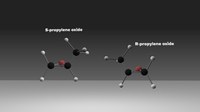Life’s First Handshake: Chiral Molecule Detected
 Life on Earth relies on chiral molecules – species that are not superimposable on their mirror images. This manifests itself in the selection of a single molecular handedness, or homochirality, across the biosphere. The authors present the astronomical detection of a chiral molecule, propylene oxide (CH3CHCH2O), in absorption toward the Galactic Center, the first complex organic chiral molecule detected in interstellar space. The research was undertaken primarily with the Green Bank Telescope (GBT) as part of the Prebiotic Interstellar Molecular Survey. Additional supporting observations were taken with the Parkes radio telescope in Australia. Propylene oxide was detected in the gas phase in a cold, extended molecular shell around the embedded, massive protostellar clusters in the Sagittarius B2 star-forming region. Complex organic molecules form in interstellar clouds like Sagittarius B2 in several ways. The most basic pathway is through gas-phase chemistry, in which particles collide and merge to produce ever more complex molecules. Once organic compounds as large as methanol (CH3OH) are produced, however, this process becomes much less efficient. To form more complex molecules, such as propylene oxide, astronomers believe thin mantles of ice on dust grains help link small molecules into longer and larger structures. These molecules can then evaporate from the surface of the grains and further react in the gas of the surrounding cloud.
Life on Earth relies on chiral molecules – species that are not superimposable on their mirror images. This manifests itself in the selection of a single molecular handedness, or homochirality, across the biosphere. The authors present the astronomical detection of a chiral molecule, propylene oxide (CH3CHCH2O), in absorption toward the Galactic Center, the first complex organic chiral molecule detected in interstellar space. The research was undertaken primarily with the Green Bank Telescope (GBT) as part of the Prebiotic Interstellar Molecular Survey. Additional supporting observations were taken with the Parkes radio telescope in Australia. Propylene oxide was detected in the gas phase in a cold, extended molecular shell around the embedded, massive protostellar clusters in the Sagittarius B2 star-forming region. Complex organic molecules form in interstellar clouds like Sagittarius B2 in several ways. The most basic pathway is through gas-phase chemistry, in which particles collide and merge to produce ever more complex molecules. Once organic compounds as large as methanol (CH3OH) are produced, however, this process becomes much less efficient. To form more complex molecules, such as propylene oxide, astronomers believe thin mantles of ice on dust grains help link small molecules into longer and larger structures. These molecules can then evaporate from the surface of the grains and further react in the gas of the surrounding cloud.
Image: The S (Latin for sinister, left) and R (Latin for rectus, right) versions of the chiral molecule propylene oxide, which was discovered in a massive star-forming region near the center of our Galaxy. This is the first detection of a chiral molecule in interstellar space. Credit: B. Saxton (NRAO/AUI/NSF)
Science Team: Brett A. McGuire (NRAO, Caltech), P. Brandon Carroll (Caltech), Ryan A. Loomis (Harvard), Ian A. Finneran (Caltech), Philip R. Jewell (NRAO), Anthony J. Remijan (NRAO), and Geoffrey A. Blake (Caltech).
Publication: Discovery of the interstellar chiral molecule propylene oxide (CH3CHCH2O), 2016 Science, 352, 1449.




Connect with NRAO